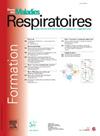气道给药丙酸提高小鼠过敏性哮喘期间的免疫耐受
IF 0.5
4区 医学
Q4 RESPIRATORY SYSTEM
引用次数: 0
摘要
过敏性哮喘的病理机制本质上是支气管内稳态的破坏,其特征是促炎介质如T和B效应细胞的增加,超过免疫调节细胞信号传导。最近的研究表明,肠道微生物代谢物SCFAs通过诱导耐受性途径,在消除哮喘的主要特征(如气道炎症和AHR)方面发挥了关键作用,并将平衡推向了内稳态恢复。目的探讨丙酸在变应性气道炎症中的免疫调节作用,以及体内、哮喘小鼠模型和体外对人B细胞行为的影响。材料与方法采用室内尘螨(HDM)变应原诱导哮喘时,经气道给药丙酸治疗(或不治疗)BALB/c小鼠,观察丙酸对哮喘的体内预防作用。通过气道高反应性(AHR)测量评估气道功能和炎症等哮喘相关特征,并分别对血液、支气管肺泡灌洗液、肺和脾进行免疫细胞谱分析。在体外,用流式细胞术检测分离纯化的人B细胞在丙酸处理或不处理后的增殖、存活和细胞内IL-10的表达。结果在体内,丙酸治疗改善了过敏性刺激后的AHR,减少了嗜酸性粒细胞、中性粒细胞和T淋巴细胞,但没有减少巨噬细胞向肺的外倾。与哮喘对照组相比,丙酸处理的过敏小鼠肺组织显示Treg细胞增加,Th2和Th17细胞减少,B调节性IL-10产生细胞和颗粒酶B细胞增加。在体外,丙酸剂量依赖性地逆转CPG, CD40L诱导的B细胞增殖和IL-10分泌。结论丙酸直接肺给药可减轻肺嗜酸性粒细胞、中性粒细胞和AHR,改善变应原诱导的气道炎症。以及Treg和B regg在体内影响细胞分化,在体外抑制B细胞增殖。作者无利益冲突需要声明。本文章由计算机程序翻译,如有差异,请以英文原文为准。
Airway-delivered propionate boost immune tolerance during allergic asthma in mice
Background
Allergic Asthma's pathomechanism is essentially a disruption of bronchial homeostasis characterized by an increase in proinflammatory mediators such as T and B effector cells, over immune regulatory cell signaling. Recent work has brought to the forefront the pivotal role of gut microbial metabolites, SCFAs, in abrogating the cardinal features of asthma, such as airway inflammation and AHR, via induction of tolerogenic pathways, tipping the balance towards homeostasis recovery.
Objective
The goal was to investigate on a broader scale the immune-regulatory role of propionate in allergic airway- inflammation, in vivo, in an asthma mouse model, and in vitro on human B cell behavior.
Material and Methods
The preventive effect of propionate was tested in vivo by treating (or not) BALB/c mice with airway-delivered propionate during house dust mite (HDM) allergen induction of asthma, at the indicated time points. Asthma-related features such as airway function and inflammation were assessed through airway hyperresponsiveness (AHR) measurement, and immune cell profile analysis performed on blood, bronchoalveolar lavage fluid, lungs and spleen, respectively. In vitro, proliferation, survival and intracellular IL-10 expression of isolated purified human B cells was determined upon propionate treatment or not, by flow cytometry.
Results
In vivo, Propionate treatment ameliorated AHR after allergic challenge and reduced eosinophil, neutrophil and T lymphocyte but not macrophages extraversion to the lungs. Lung tissue from propionate treated allergic mice showed increased Treg cells, decreased Th2 and Th17 cells and increased B regulatory IL-10 producing cells and Granzyme B cells compared to asthmatic controls. In vitro, propionate dose dependently reversed CPG, CD40L induced B cell proliferation and IL-10 secretion.
Conclusion
Direct lung delivery of propionate improved allergen-induced airway inflammation by attenuating lung eosinophilia, neutrophilia and AHR. As well as Treg and B reg over effector cell differentiation in vivo and inhibited B cell Proliferation in vitro. Authors do not have conflict of interest to declare.
求助全文
通过发布文献求助,成功后即可免费获取论文全文。
去求助
来源期刊

Revue des maladies respiratoires
医学-呼吸系统
CiteScore
1.10
自引率
16.70%
发文量
168
审稿时长
4-8 weeks
期刊介绍:
La Revue des Maladies Respiratoires est l''organe officiel d''expression scientifique de la Société de Pneumologie de Langue Française (SPLF). Il s''agit d''un média professionnel francophone, à vocation internationale et accessible ici.
La Revue des Maladies Respiratoires est un outil de formation professionnelle post-universitaire pour l''ensemble de la communauté pneumologique francophone. Elle publie sur son site différentes variétés d''articles scientifiques concernant la Pneumologie :
- Editoriaux,
- Articles originaux,
- Revues générales,
- Articles de synthèses,
- Recommandations d''experts et textes de consensus,
- Séries thématiques,
- Cas cliniques,
- Articles « images et diagnostics »,
- Fiches techniques,
- Lettres à la rédaction.
 求助内容:
求助内容: 应助结果提醒方式:
应助结果提醒方式:


